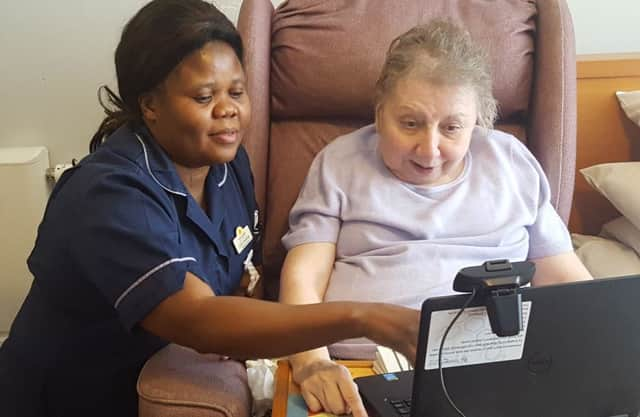Hi-tech solution to monitoring health in Leeds care homes


Six Leeds care homes and eight in Harrogate are involved in a pilot scheme which allows health and care staff to remotely monitor the health of residents.
The NHS England-funded project means that one of the homes involved, Sunnyside Care Home in Crossgates, is using telehealth so the condition of their residents can be remotely assessed and staff can communicate directly with doctors and nurses. The technology also helps reduce the need for hospital admissions as any potential health issues can be identified early and treated.
Advertisement
Hide AdAdvertisement
Hide AdSince the pilot started just before Christmas, staff at Sunnyside have used the technology to help a patient who was nearing the end of their life by involving a family member in their care. In other residents, it helped identify a health problem and also prevented another being taken into hospital as their issues were treated quickly before they escalated.
One of those to benefit is Mavis Robinson who was diagnosed with motor neurone disease (MND) in 2001.
Since being diagnosed, the 74-year-old’s health has worsened.
Julie Brown, director of Camellia and Bluebell Care Services, said: “Since using telehealth we’ve allayed some of the anxiety felt by residents and their family members whenever a health complication arises. People like Mavis, who have a chronic health condition, can often find that their condition can worsen quite quickly.
Advertisement
Hide AdAdvertisement
Hide Ad“Now my staff have the ability to consult other health care professionals quickly without waiting for a GP or out of hours doctor visit and to get the right treatment in place promptly. This helps reduce the risk of a hospital admission.
“One of my highlights has been how we were able to support Mavis over the festive period when we picked up, through telehealth, a potential decline in her health. Within two hours we’d managed to get in touch with an out of hours pharmacist so that we could get her medication for her pain.”
Mavis added: “It’s good to be able to discuss my health with my nurse especially with the information we get from telehealth. I can work with my nurse to see if there’s been any changes.
“It’s also comforting for me to know that people can check up on me without always having to see me face to face.
Advertisement
Hide AdAdvertisement
Hide Ad“There are times when my GP will need to come in and see me based on the information they’ve got from my telehealth device, this is reassuring and means I can get help much quicker. And I’m really happy if it means I don’t have to go to hospital.”
The pilot is using telemonitoring to keep tabs on things like blood pressure and sending results to medics.
It is part of NHS England’s West Yorkshire and Harrogate Acceleration Zone, an £8m initiative to improve urgent and emergency care.
Sue Robins, director of commissioning, strategy and performance at NHS Leeds West CCG, said: “We’ll share our learning from the pilot with colleagues regionally and nationally to see how technology could help the NHS in the future.”